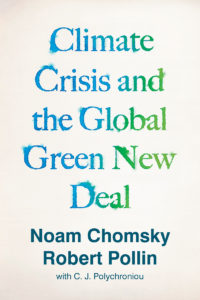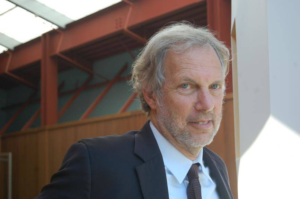The Political Economy Of Saving The Planet. An Interview With Noam Chomsky & Robert Pollin
No Comments yetWhat needs to be done to advance a successful political mobilization on behalf of a global Green New Deal—a program that includes emissions reductions, expands renewable energy sources, addresses the needs of vulnerable workers, and promotes sustainable and egalitarian economic growth? Political scientist C. J. Polychroniou spoke with Noam Chomsky and economist Robert Pollin, who has been at the forefront of the fight for an egalitarian green economy for more than a decade, to discuss prospects for change, the connections between climate and the COVID-19 pandemic, and whether eco-socialism is a viable option for mobilizing people in the struggle to create a green future.
This conversation was adapted from Chomsky and Pollin’s new book Climate Crisis and the Global Green New Deal: The Political Economy of Saving the Planet.
C. J. Polychroniou: How does the coronavirus pandemic, and the response to it, shed light on how we should think about climate change and the prospects for a global Green New Deal?
Noam Chomsky: At the time of writing, concern for the COVID-19 crisis is virtually all-consuming. That’s understandable. It is severe and is severely disrupting lives. But it will pass, though at horrendous cost, and there will be recovery. There will not be recovery from the melting of the arctic ice sheets and the other consequences of global warming.
Not everyone is ignoring the advancing existential crisis. The sociopaths dedicated to accelerating the disaster continue to pursue their efforts, relentlessly. As before, Trump and his courtiers take pride in leading the race to destruction. As the United States was becoming the epicenter of the pandemic, thanks in no small measure to their folly, the White House cabal released its budget proposals. As expected, the proposals call for even deeper cuts in healthcare support and environmental protection, instead favoring the bloated military and the building of Trump’s Great Wall. And to add an extra touch of sadism, the budget promotes a fossil fuel ‘energy boom’ in the United States, including an increase in the production of natural gas and crude oil.”
Meanwhile, to drive another nail in the coffin that Trump and associates are preparing for the nation and the world, their corporate-run EPA weakened auto emission standards, thus enhancing environmental destruction and killing more people from pollution. As expected, fossil fuel companies are lining up in the forefront of the appeals of the corporate sector to the nanny state, pleading once again for the generous public to rescue them from the consequences of their misdeeds.
In brief, the criminal classes are relentless in their pursuit of power and profit, whatever the human consequences. And those consequences will be disastrous if their efforts are not countered, indeed overwhelmed, by those concerned for “the survival of humanity.” It is no time to mince words out of misplaced politeness. “The survival of humanity” is at risk on our present course, to quote a leaked internal memo from JPMorgan Chase, America’s largest bank, referring specifically to the bank’s genocidal policy of funding fossil fuel production.
One heartening feature of the present crisis is the rise in community organizations starting mutual aid efforts. These could become centers for confronting the challenges that are already eroding the foundations of the social order. The courage of doctors and nurses, laboring under miserable conditions imposed by decades of socioeconomic lunacy, is a tribute to the resources of the human spirit. There are ways forward. The opportunities cannot be allowed to lapse.
Robert Pollin: In addition to the fundamental considerations that Noam has emphasized, there are several other ways in which the climate crisis and the coronavirus pandemic intersect. One underlying cause of the COVID-19 outbreak—as well as other recent epidemics such as Ebola, West Nile, and HIV—has been the destruction of animal habitats through deforestation and human encroachment, as well as the disruption of the remaining habitat through the increasing frequency and severity of heat waves, droughts, and floods. As the science journalist Sonia Shah wrote in February 2020, habitat destruction increases the likelihood that wild species “will come into repeated intimate contact with the human settlements expanding into their newly fragmented habitats. It’s this kind of repeated, intimate contact that allows the microbes that live in their bodies to cross over into ours, transforming benign animal microbes into deadly human pathogens.”
It is also likely that people who are exposed to dangerous levels of air pollution will face more severe health consequences than those breathing cleaner air. Aaron Bernstein of Harvard’s Center for Climate, Health, and the Global Environment states that “air pollution is strongly associated with people’s risk of getting pneumonia and other respiratory infections and with getting sicker when they do get pneumonia. A study done on SARS, a virus closely related to COVID-19, found that people who breathed dirtier air were about twice as likely to die from the infection.”
A separate point that was raised over the worst months of the COVID-19 pandemic was that the responses in the countries that immediately handled the crisis more effectively, such as South Korea, Taiwan, and Singapore, demonstrated that governments are capable of taking decisive and effective action in the face of crisis. The death tolls from COVID-19 in these countries were negligible, and normal life returned relatively soon after governments imposed initial lockdowns. Similarly decisive interventions could successfully deal with the climate crisis where the political will is strong and the public sectors are competent.
There are important elements of truth in such views, but we should also be careful to not push this point too far. Some commentators have argued that one silver lining outcome of the pandemic was that, because of the economic lockdown, fossil fuel consumption and CO2 emissions plunged alongside overall economic activity during the recession. While this is true, I do not see any positive lessons here with respect to advancing a viable emissions program that can get us to net zero emissions by 2050. Rather, the experience demonstrates why a degrowth approach to emissions reduction is unworkable. Emissions did indeed fall sharply because of the pandemic and the recession. But that is only because incomes collapsed and unemployment spiked over this same period. This only reinforces the conclusion that the only effective climate stabilization path is the Green New Deal, as it is the only one that does not require a drastic contraction (or “degrowth”) of jobs and incomes to drive down emissions.
A genuinely positive development of the pandemic and recession is that progressive activists around the world have fought to include Green New Deal investments in their countries’ economic stimulus programs. It is critical to keep pushing the development and success of these initiatives.
In support of that end, we must seriously consider how to best maximize both the short-term stimulus benefits and long-term impacts of Green New Deal programs. I know the importance of such considerations from personal experience working on the green investment components of the 2009 Obama American Recovery and Reinvestment Act, in which $90 billion of the $800 billion total was allocated to clean energy investments in the United States. The principles underlying these investment components were sound, but the people who worked on the program in its various stages, including myself, did not adequately calculate the time necessary to execute many of the projects. We knew that it was critical to identify “shovel-ready” projects—ones that could be quickly implemented on a large scale and provide an immediate economic boost. But relatively few green investment projects were truly shovel-ready at that time, as the green energy industry was still a newly emerging enterprise. Therefore, the backlog of significant new projects was thin. It is only moderately less thin today.
This means that people designing Green New Deal stimulus programs must identify the subgroup of green investment projects that can realistically roll into action at scale within a matter of months. One example that should be applicable in almost every country would be energy efficiency retrofits of all public and commercial buildings. This would entail improving insulation, sealing window frames and doors, switching over all lightbulbs to LEDs, and replacing aging heating and air conditioning systems with efficient ones (preferably heat pumps). These programs could quickly generate large numbers of jobs for secretaries, truck drivers, accountants, construction workers, and climate engineers. They could also save energy and reduce emissions quickly and relatively cheaply. Building off of such truly shovel-ready projects, the rest of the clean energy investment program could then accelerate and provide a strong foundation for economies moving out of recession and onto a sustainable recovery path.
CP: Eco-socialism is becoming a major tenet of the ideological repertoire of green parties in European countries and elsewhere, which may be the reason for their increasing appeal with voters and especially the youth. Is eco-socialism a cohesive enough political project to be taken seriously as an alternative for the future?
NC: Insofar as I understand eco-socialism—not in great depth—it overlaps greatly with other left socialist currents. That being said, I don’t think we’re at a stage where adopting a specific “political project” is very helpful. There are crucial issues that have to be addressed, right now. Our efforts should be informed by the kind of future society that we want, and the kind that can be constructed within our existing society. It’s fine to stake out specific positions about the future in more or less detail, but for now these seem to me at best ways of sharpening ideas rather that platforms to latch on to.
A good argument can be made that inherent features of capitalism lead inexorably to the ruin of the environment, and that ending capitalism must be a priority of the environmental movement. But there’s one fundamental problem with this argument: time scales. Dismantling capitalism is impossible in the time frame that we have for taking urgent action, which requires national and international mobilization if severe crisis is to be averted.
Furthermore, the whole discussion around eco-socialism is misleading. The two efforts—averting environmental disaster, and dismantling capitalism in favor of a freer and more just society—should and can proceed in parallel. One example is Tony Mazzocchi’s efforts to forge a labor coalition that would not only challenge owner-management control of the workplace, but also be at the forefront of the environmental movement while attempting to socialize major sectors of U.S. industry. There’s no time to waste. The struggle must be, and can be, undertaken on all fronts.
CP: Bob, in your view, can eco-socialism coexist with the Green New Deal project? And, if not, what type of a politico-ideological agenda might be needed to generate broad political participation in the struggle to create a green future?
RP: In my view, details of rhetoric and emphasis aside, eco-socialism and the Green New Deal are fundamentally the same project. The Green New Deal, as we have discussed the term, offers the only path to climate stabilization that can also expand good job opportunities and raise living standards in all regions of the world. It defines an explicit and viable alternative to austerity economics on a global scale. My coworkers and I have worked on this issue—advancing the Green New Deal as an alternative to austerity economics—in different country settings over the past few years, including in Spain, Puerto Rico, and Greece. In my view, the Green New Deal is the only approach to climate stabilization also capable of reversing rising inequality and defeating global neoliberalism and ascendant neofascism.
Beyond the Green New Deal, I don’t know what exactly “eco-socialism” could mean. Does it mean the overthrow of all private ownership of productive assets for public ownership? As Noam suggested, do people seriously think that this could happen within the time frame we have to stabilize the climate, that is, within less than thirty years? And are we certain that eliminating all private ownership would be workable or desirable from a social justice standpoint—i.e. from the standpoint of advancing well-being for the global working class and poor? How do we deal with the fact that most of the world’s energy assets are already publicly owned? How, more specifically, can we be certain that a transition to complete public ownership would itself deliver zero net emissions by 2050? To me, the overarching challenge is trying to understand alternative pathways to most effectively building truly egalitarian, democratic, and ecologically sustainable societies—putting all labels aside and being willing, as Marx himself insisted, to employ “ruthless criticism” toward all that exists, including all past experiences with Communism and Socialism. And, for that matter, being open to criticizing all authors, including Marx himself. Indeed, my favorite quote from Marx is “I am not a Marxist.”
We have only briefly touched on “planetary boundaries” besides the climate crisis, including air and water pollution, as well as biodiversity losses. I understand that the eco-socialist movement gives substantial attention to these critical environmental issues. I share their concerns and welcome the focus they bring to these issues. We have concentrated here on the climate crisis for the simple reason that it is the matter of greatest urgency.
 CP: Europe’s civil disobedience movement, led by Extinction Rebellion protesters as a strategy to tackle the climate crisis and create a just and sustainable world, is growing by leaps and bounds, especially among young people, but it also seems to annoy many citizens and may even be alienating the general public. Noam, can you share with us your thoughts on the strategy of massive civil disobedience as a way to tackle the climate emergency?
CP: Europe’s civil disobedience movement, led by Extinction Rebellion protesters as a strategy to tackle the climate crisis and create a just and sustainable world, is growing by leaps and bounds, especially among young people, but it also seems to annoy many citizens and may even be alienating the general public. Noam, can you share with us your thoughts on the strategy of massive civil disobedience as a way to tackle the climate emergency?
NC: I was involved in civil disobedience for many years, sometimes intensely, and think it’s a reasonable tactic—sometimes. It should not be adopted merely because one feels strongly about the issue and wants to display that to the world. That tactic can be proper, but it’s not enough. It’s necessary to consider the consequences. Is the action designed in a way that will encourage others to think, to understand, to join? Or is it more likely to antagonize, to irritate, and to cause people to support the very thing being protested? Tactical considerations are often denigrated— “that’s for small minds, not for a serious, principled guy like me.” Quite the contrary. Tactical judgments have direct human consequences. They are a deeply principled concern. It’s not enough to think, “I’m right, and if others can’t see it, too bad for them.” Such attitudes often cause serious harm.
But I don’t think there is a general answer to your question. It depends on the circumstances, the nature of the planned action, and the likely consequences as best we can ascertain them.
CP: Bob, where do you stand on this question?
RP: I would just add that any and all tactics that might move us closer to solving the climate crisis should be considered seriously. This includes civil disobedience. But we also have to consider the negative effects of civil disobedience’s success. For example, if roads or public transportation systems are shut down on weekdays, then people can’t get to work, parents can’t pick up their kids at daycare, and sick people can’t make it to the doctor’s office. Such consequences will only reinforce the view that already exists—whether fair or unfair—that climate activists don’t care about the lives of ordinary people. Actions that strengthen this view in the general public are politically disastrous.
As it is, this view is already nurtured when climate activists don’t show genuine commitment to transition programs for the workers and communities that will be hurt by the shutdown of the fossil fuel industry. This view is further strengthened when climate activists favor carbon taxes without 100 percent rebates for most of the population, starting with lower-income people. These rebates compensate people for the cost-of-living increases they will face simply by driving their cars or using electricity in their homes. The Yellow Vest movement that emerged in France in 2018 to oppose the diesel tax proposals of the thoroughly tone-deaf President Emmanuel Macron is one obvious example here.
Civil disobedience should certainly be included as a tactic if it becomes clear that it will be truly effective. By “effective” I mean helpful to advancing a Green New Deal project capable of delivering a zero emissions global economy by 2050.
CP: As we have discussed, neoliberalism is still dominant, and even more dangerous neofascist social movements are on the rise. In this context, the prospects of energizing voters in order to demand fundamental levels of political mobilization to confront the climate crisis do not appear particularly promising. In fact, it seems that it is mainly the youth who are insisting that we address climate change with the level of urgency it demands. In that context, what do you think it would take to turn things around and elevate climate change to the very top of the public agenda worldwide? Noam, let’s start with you.
NC: It has become almost de rigueur these days to cite Gramsci’s observation, from Mussolini’s prison, that “the old is dying and the new cannot be born; in this interregnum, a great variety of morbid symptoms appear.”
Neoliberalism may remain the dominant elite mantra, but it is visibly tottering. It has delivered a harsh impact to the general population almost everywhere. In the United States, nearly half the population has negative net worth, while 0.1 percent hold more than 20 percent of wealth—as much as the lowest 90 percent. Moreover, obscene wealth concentration is increasing along with its direct impact on the decline of functioning democracy and social welfare. In Europe the impact is in some ways worse, even if somewhat cushioned by the residue of social democracy. And morbid symptoms are everywhere: anger; resentment; increasing racism, xenophobia, and hatred of scapegoats (immigrants, minorities, Muslims, etc); the rise of demagogues who stoke these fears and exploit the social pathologies that surface in times of confusion and despair; and, in the international arena, the emergence of a reactionary international headed by the White House and incorporating figures such as Jair Bolsonaro, Mohammed bin Salman Al Saud, Abdel Fattah al-Sisi, Benjamin Netanyahu, Narendra Modi, Viktor Orbán, and the rest. But such morbid symptoms are countered by rising activism. The new has not yet been born, but it is emerging in many intricate ways and it is far from clear what form it will take.
Much is unpredictable, but there are a few things that we can say with confidence: unless the new that is taking shape confronts the twin imminent threats to survival—nuclear war and environmental catastrophe—and does so quickly and forcefully, it won’t matter what else happens.
CP: Bob, what are your thoughts on the matter?
RP: I will start with another apt aphorism from Antonio Gramsci: “Pessimism of the mind; optimism of the will.” That is, if we take climate science seriously and then examine where the world is today, the odds of us moving the world onto a viable climate stabilization path—specifically, of hitting the IPCC’s stated target of net zero CO2 emissions by 2050—are shaky at best. On the other hand, to invoke Margaret Thatcher’s famous dictum, “there is no alternative” to doing everything possible to accomplish these goals.
With respect to “optimism of the will,” we can point to the rapidly growing tide of climate activism that has delivered major breakthroughs. Most emphatically, this includes the September 2019 global Climate Strike, led by the remarkable Swedish teenager Greta Thunberg. Estimates place between 6 and 7.5 million people participating in 4,500 locations in 150 countries.
The Climate Strike reflects equally significant, if less visible, developments around the world. One example is the successful movement in the western Mediterranean countries, including Spain, France, and Italy, to outlaw new oil and gas exploration and drilling, as well as to phase out existing projects. These very recent political breakthroughs started around 2016. In Spain, from 2010 to 2014–with the country then suffering from the aftershocks of the global financial crisis and Great Recession—government officials signed more than one hundred permits with oil companies to start new exploration and drilling projects throughout the country. But environmental activists joined forces with business owners in the tourism industry to mount a successful resistance against fossil fuel development as an economic recovery plan. The government’s efforts to counter the economic crisis by opening the country to oil exploration and drilling were “a bad dream,” in the words of one municipal official from the Spanish island of Ibiza. “We luckily woke up,” he said.
This type of grassroots climate activism throughout Western Europe has also led the European Commission to officially establish its European Green Deal project. The overarching aim is for the entire continent to achieve the IPCC’s goal of net zero emissions. As of early 2020, both legislative bodies of the EU, the European Council and European Parliament, had voted to endorse the project. Of course, legislative bodies passing resolutions is the easy job. Whether European residents have the will to follow through on these commitments remains an open question.
Similar movements are gaining momentum in the United States, despite the buffoonish climate denialism of President Donald Trump. In June 2019, New York state passed the most ambitious set of climate targets in the country, including carbon-free electricity by 2040 and a net zero emissions economy by 2050. The New York initiative follows similar measures, if somewhat less ambitious measures to date, in California, Oregon, Washington, Colorado, New Mexico, and Maine. One major factor in these U.S. state-level developments is the increasing participation of the mainstream labor movement. Union members have assumed major leadership roles in some cases. These state-level measures now need to incorporate substantial and just transition programs for workers and communities whose livelihoods currently depend on the fossil fuel industry. These people and communities are facing major hits to their living standards in the absence of generous transition programs. By bringing just transition considerations to the forefront of the climate movement, the unions are building on the legacy of the visionary labor leader Tony Mazzocchi that Noam discussed earlier.
Climate movements remain at modest levels throughout most low- and middle-income countries, but there is a reasonable chance that will change quickly. Activism is growing, alongside coalitions among environmentalists, labor groups, and business sectors. One reason for mobilization is that air pollution is rendering virtually all the major cities in low- and middle-income countries unlivable, including Delhi, Mumbai, Shanghai, Beijing, Lagos, Cairo, and Mexico City. Aman Sharma, a young Climate Strike activist in Delhi, told the Guardian in September 2019, “We are out here to reclaim our right to live, our right to breathe and our right to exist, which is all being denied to us by an inefficient policy system that gives more deference to industrial and financial objectives rather than environmental standards.”
A critical factor in advancing this movement, in developing countries and elsewhere, is demonstrating how climate stabilization coincides with the expansion of decent work opportunities, raising mass living standards, and fighting poverty in all regions of the world. This must be recognized as the core proposition undergirding the global Green New Deal. Advancing a viable global Green New Deal should therefore be understood as the means by which “optimism of the will” comes alive in defining the political economy of saving the planet.
Originally published: http://bostonreview.net/science-nature-global-justice/noam-chomsky-robert-pollin-c-j-polychroniou-political-economy-saving
You May Also Like
Comments
Leave a Reply









